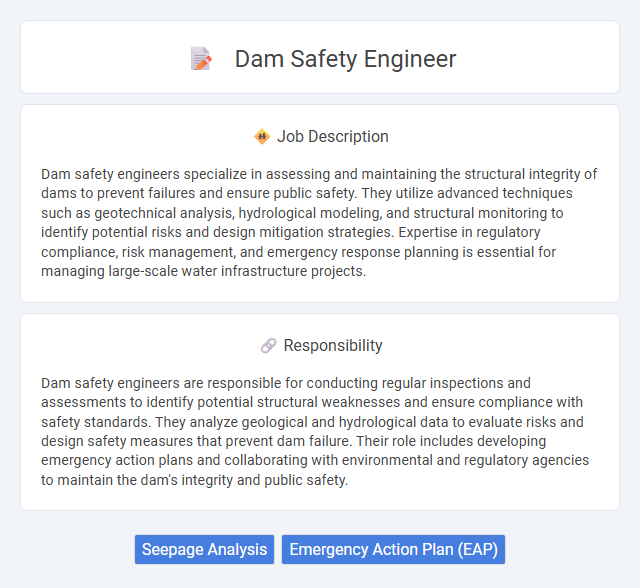
Dam safety engineers specialize in assessing and maintaining the structural integrity of dams to prevent failures and ensure public safety. They utilize advanced techniques such as geotechnical analysis, hydrological modeling, and structural monitoring to identify potential risks and design mitigation strategies. Expertise in regulatory compliance, risk management, and emergency response planning is essential for managing large-scale water infrastructure projects.
Individuals with strong analytical skills and a background in civil or structural engineering are likely suitable for a dam safety engineer role. Those comfortable with field inspections, risk assessment, and problem-solving under pressure may find this job aligns well with their abilities. People who prefer routine tasks or lack attention to detail might struggle to meet the demands of ensuring infrastructure safety and regulatory compliance.
Qualification
Dam safety engineers typically require a bachelor's degree in civil, structural, or geotechnical engineering, often complemented by advanced certifications such as Professional Engineer (PE) licensure. Key qualifications include expertise in hydraulics, soil mechanics, and structural analysis, alongside proficiency in risk assessment and failure mode evaluation. Practical experience in dam design, inspection, and maintenance significantly enhances qualifications for this specialized role.
Responsibility
Dam safety engineers are responsible for conducting regular inspections and assessments to identify potential structural weaknesses and ensure compliance with safety standards. They analyze geological and hydrological data to evaluate risks and design safety measures that prevent dam failure. Their role includes developing emergency action plans and collaborating with environmental and regulatory agencies to maintain the dam's integrity and public safety.
Benefit
A career as a dam safety engineer likely offers substantial benefits, including job stability due to the critical nature of infrastructure maintenance and public safety. Engineers in this field probably enjoy competitive salaries and opportunities for professional development through ongoing training and certification programs. The role might also provide a sense of fulfillment, as their work directly contributes to preventing disasters and protecting communities.
Challenge
Dam safety engineer roles likely involve confronting complex challenges related to structural integrity and risk management. The probability of facing unexpected environmental factors or aging infrastructure issues may demand innovative problem-solving skills. Ensuring public safety while complying with strict regulatory standards could present a consistent and demanding challenge.
Career Advancement
A Dam Safety Engineer specializes in assessing structural integrity and managing risks to ensure dam stability and public safety. Career advancement typically involves progressing from entry-level engineering roles to senior positions such as Lead Dam Safety Engineer or Project Manager, often requiring advanced certifications and expertise in hydrology, geotechnical analysis, and regulatory compliance. Professionals may also transition into executive roles within government agencies or engineering consulting firms, leveraging their experience in risk management and infrastructure resilience.
Key Terms
Seepage Analysis
Dam safety engineers specializing in seepage analysis evaluate water flow through and beneath dams to prevent structural failure. They utilize advanced modeling software such as SEEP/W to assess seepage patterns, pore water pressure, and potential erosion risks. Effective seepage analysis ensures stability, mitigates risks of piping, and informs maintenance and remediation strategies to safeguard dam integrity.
Emergency Action Plan (EAP)
Dam safety engineers develop and implement Emergency Action Plans (EAP) to mitigate risks associated with dam failures. These plans include hazard assessment, communication protocols, and evacuation procedures to ensure public safety during emergencies. Regular EAP updates and drills are essential to enhance preparedness and effective response to potential dam incidents.
 kuljobs.com
kuljobs.com